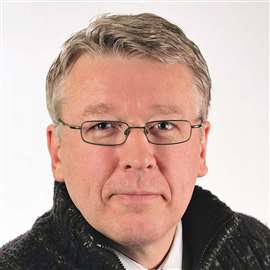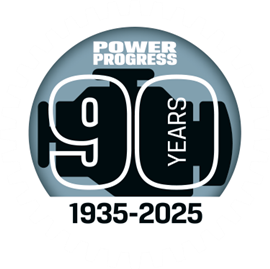Deere diversifies with, and beyond, diesels
03 June 2025
Like many engine manufacturers, John Deere Power Systems (JDPS) is exploring technologies outside of diesel engines. But that doesn’t mean it’s given up on its core products. In fact, at Bauma 2025, its next-generation diesels held pride of place in its booth.
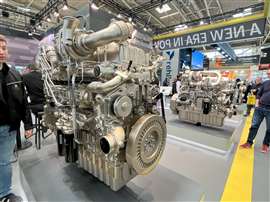 The JD14 and JD18 Next Generation engines come in variants for both industrial and marine applications. (Photo: Becky Schultz)
The JD14 and JD18 Next Generation engines come in variants for both industrial and marine applications. (Photo: Becky Schultz)
Front and center were the 3.9 L JD4 four-cylinder, the 13.6 L JD14 and the 18 L JD18 six-cylinder, turbocharged and air-to-air aftercooled diesel engines, all of which are Tier 4 Final/Stage V certified.
“The JD4 is a new, clean sheet engine hitting production in 2026. The JD14 and the JD18 were also clean sheet engines we introduced over the last few years,” said Eric Risius, manager – Power Solutions & Combustion Engines, John Deere Power Systems. “
The company is also revamping select existing engines, including the JD9 shown at the event, which Risius described as a “major improvement to one of our legacy engines.” The performance of the existing 9.0 L engine has been optimized to offer lower complexity and installation costs.
Smaller, economical packaging
The new JD4 engine is rated 63-129 kW/84-173 hp and has bore x stroke dimensions of 3.9” x 5.0”. It includes a wastegated turbocharger, selective catalytic reduction (SCR) and a high-pressure common rail (HPCR) fuel system.
 The 3.9 L JD4 offers comparable power density to Deere’s 4.5 L model. (Photo: Becky Schultz)
The 3.9 L JD4 offers comparable power density to Deere’s 4.5 L model. (Photo: Becky Schultz)
“It’s a combination of a partnered engine we have with Deutz but with the Deere twist,” Risius pointed out. “We have our own controls, our own aftermarket systems, so it’s a new engine to us. It gives us the ability to hit scale with it a bit better and really put the Deere stamp on the reliability and performance.”
The JD4 is “a modern architected engine,” said Risius, that fits snugly within the current product range. “We have a 2.9 L that we’ve had in the market for a while and a 4.5 L, so it gives a good lower price point/entry point and a smaller packaging size from our 4.5 L.”
Whereas the 4.5 L is targeted to high-duty cycle applications, the JD4 is designed to be a well-priced alternative offering comparable power density.
“By ‘clean sheeting’ it, you can hit power density levels and higher cylinder pressure levels in [the JD4] than our legacy engines. That lets you get 3.9 L displacement producing a similar power level to our legacy 4.5 L, and that generates a big cost savings in packaging,” Risius explained.
Off-road legacy
The two larger engines come in variants for both industrial and marine applications. The marine engines were announced in January 2025, and the industrial engines featured at Bauma.
The JD14 industrial diesel is rated 300-510 kW/402-684 hp at 2,100 rpm and has a bore x stroke of 5.2” x 6.5”. It incorporates cooled exhaust gas recirculation (EGR) and SCR. The JD18 provides 522-677 kW/700-908 hp and has a bore x stroke of 5.8” x 6.8”. It includes cooled EGR and a HPCR fuel system.
“What sets both the JD14 and the JD 18 apart is their off-road legacy,” Risius stated. “Their roots are in a purely off-road driven environment, built for the heaviest of duty cycles. Deere only does heavy-duty off-road applications. There’s no on-road influence in our designs, so that alone really hits durability in a production class environment that we think stands out.”
The new engines feature “tried and heavily tested” systems or components used in “many of our largest, hardest working Deere applications,” Risius continued. “So, we’ve sort of put our money where our mouth is in the usage and the trust.”
Renewable fuels
As part of its future-forward approach, JDPS has made the integration of renewable fuels into internal combustion engines another big area of focus.
“When we talk about renewable fuels, we talk about fuels in liquid form – being much more of a match to some of the traditional Deere applications – but also gaseous fuels for future work,” Risius said. “It’s an area we’re monitoring and doing research projects around to envision the applications in ag and construction environments.”
Biomethane and green hydrogen show promise on the gaseous side. “On the liquid fuels, all our engines are HVO compatible and ready to go, so that’s a drop-in solution,” said Risius. Biodiesel in blends based on the tier level for the specific region are also approved for use.
“Something that we’re actively investigating but not to market with is ethanol. It’s a widely available fuel, at least in North and South America,” Risius continued. “It is in liquid form, has good energy density and is one that could be a possible solution.”
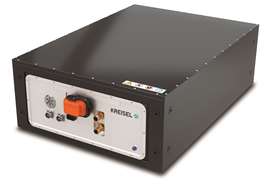 The KBE.59.750M battery is part of a new range featuring flexible, modular architecture for optimal battery placement. (Photo: John Deere Power Systems)
The KBE.59.750M battery is part of a new range featuring flexible, modular architecture for optimal battery placement. (Photo: John Deere Power Systems)
However, ethanol calls for a departure from the compression-ignited technology that JDPS normally leverages. “It’s a spark-ignited path, so that is a new engine technology for us to bring to market, but we’ve been researching it for years now,” Risius noted.
Beyond fuels, the next step is likely battery-electric power. “We see that as a very viable product, more so on the smaller power ranges,” said Risius.
Joint effort
Aiding JDPS as it moves further into electrification is Kreisel Electric, of which John Deere acquired majority ownership in 2022.
“One of the reasons that [John Deere] invested in Kreisel is that they have a form of thermal management for the battery where the cell is completely immersed in a non-conducive fuel,” said Martin Ryley, Worldwide Business Development Manager, John Deere Power Systems. This immersion cooling technology, in combination with the battery control, is referred to as Dynamic Performance Management.
“What it does is it allows you to optimize performance at much higher and lower ambient temperatures, and it maximizes battery life,” Ryley explained. “It adds a lot to the safety of the battery because if there’s a thermal event, if one of the cells misbehaves, it’s isolated to one cell... So, there’s an awful lot of advantages to it.”
The technology is used in the 63-kWh KBP63 battery pack currently in serial production, and it will be a core part of a new range of batteries in development featuring a flexible, modular architecture for optimal battery placement. Demonstrating what’s to come, the KBE.59.750M was on display at Bauma, and the full range – including the KBE24.450, KBE60.400, KBE.39.750C, KBE39.750S and KBE59.750 – is slated for production beginning in 2026.
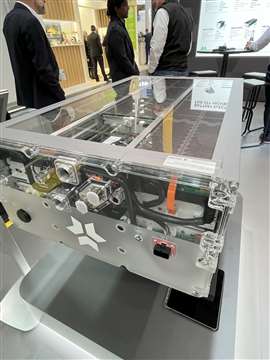 Batteries from John Deere and Kreisel feature Dynamic Performance Management for added safety and extended battery life. (Photo: Becky Schultz)
Batteries from John Deere and Kreisel feature Dynamic Performance Management for added safety and extended battery life. (Photo: Becky Schultz)
“We’re going to have a 24, a 39 and a 60 kWh, either in flat or cubic form,” said Ryley. Adding more forms will make it easier for the battery packs to be installed in a broader range of equipment.
Currently, the battery packs are produced out of Kreisel’s plant in Austria, with plans to start production at a John Deere engine factory in France in 2026.
“What’s really crucial is that for anybody now starting new development of a concept or a machine, we can already make the prototypes available. We’re already working with customers now with these new form factors,” Ryley said, “so that by the time they’re ready for production, we’ll be scaled and ready to support them.”
On-site charging
In addition to battery packs, JDPS and Kreisel are developing stationary and mobile charging options to support electric-powered vehicles and equipment where typical grid infrastructure is insufficient or unavailable.
On display in the Wirtgen booth at Bauma was Kriesel’s Chimero, a battery integrated high-power stationary charger for DC fast charging in locations where a fixed charging solution is preferred and only lower grid connections are available. The charger has a power output of up to 240 kW, with an integrated battery designed to supplement the available grid connection.
Also featured was a concept mobile DC fast charging solution for construction and agricultural applications where grid power is not available. The unit is designed to be charged at a yard, depot, or public charging sites using either DC fast or overnight charging. Then the unit can be taken out to the worksite to provide on-site power for both BEVs and for AC applications.
“This is like a mobile generator for DC power. But the thing is, because it’s designed to go on site, it’s designed to operate in rugged environments,” Ryley pointed out.
Everybody is looking for solutions to support electrification on site, he commented. “It’s just how quickly you move forward with it. We’ve got a concept that shows that we’re thinking ahead.”
POWER SOURCING GUIDE
The trusted reference and buyer’s guide for 83 years
The original “desktop search engine,” guiding nearly 10,000 users in more than 90 countries it is the primary reference for specifications and details on all the components that go into engine systems.
Visit Now
STAY CONNECTED




Receive the information you need when you need it through our world-leading magazines, newsletters and daily briefings.
CONNECT WITH THE TEAM

